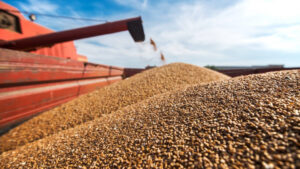
Benchmark oil prices continued to rise on Tuesday after hitting new annual highs the day before on fears of a fuel shortage in the global market.
The price of November futures for Brent on the London ICE Futures exchange at 8:15 a.m. is $95.03 per barrel, which is 60 cents (0.64%) higher than at the close of the previous session. On Monday, these contracts rose by $0.5 (0.5%) to $94.43 per barrel.
Quotes for WTI futures for October in electronic trading on the New York Mercantile Exchange (NYMEX) by this time increased by $1.01 (1.1%) to $92.49 per barrel. At the end of the previous session, they rose by $0.71 (0.8%) to $91.48 per barrel.
The day before, Brent had updated its record from November 11 last year, and WTI – from November 7.
“Oil is maintaining its upward momentum thanks to some signs of a Chinese economic recovery,” said Tim Waterer, senior market analyst at KCM Trade. In particular, he pointed to the improvement in industrial production and consumer spending last month, as well as the growth of retail sales by 4.6% in August in annual terms.
“WTI is trying to gain a foothold above $90 per barrel,” he added.
“The current bullish trend is likely to be driven by non-OPEC production, especially shale oil and gas production in the US, in response to rising prices,” said Robbie Fraser of Schneider Electric. – “We are seeing the first signs of this dynamic, but it needs to be stronger and more consistent to have an impact on the market.

Agroprosperis agricultural group has supplied 17 thousand tons of agricultural products to Italy and Spain through the ports of Croatia since the beginning of 2023, the press service of the agricultural holding reported.
“In the first weeks of September of this year, Ukrainian and world media were abuzz with the news that Ukraine started exporting grain through the seaports of Croatia. “Agroprosperis is among the domestic exporters who were the first to use this route this year. It has become an important step in the expansion of Ukrainian agro-logistics against the background of the aggressor’s blockade of the grain corridor from the deep-water ports of the Black Sea,” the company’s website reported.
The agroholding noted that it was familiar with this export channel and had used it in previous years. During 2021-2022, the agroholding shipped 4,000 tons of GMO-free soybeans to Italy through Croatian ports for export. Since the beginning of the 2023-2024 marketing year, 6 thousand tons of corn were shipped to Italy and 11 thousand tons of wheat to Spain.
Currently, Agroprosperis is implementing a program of accumulation of wheat and soybeans for customers in Egypt and Europe.
According to the report, the structural subdivisions of the agroholding continue production of agricultural products and their export through alternative logistic routes. Agroprosperis noted the selfless work of its subdivisions in Sumy and Chernihiv regions, which grow, take care of crops and harvest crops under shelling.
In addition, the Agroprosperis Charitable Foundation is also active, providing direct assistance to 2,400 war victims totaling more than UAH 30 million.
Before the Russian military invasion, Agroprosperis had a land bank of 430 thousand hectares and total storage capacity of 800 thousand tons of crops. The holding grew and exported more than 2 million tons of grain and oilseeds per year.
“Agroprosperis operates through five divisions: Golden Sunrise (Agro), Bio Agro, Ray Agro, Latagro, New Agro Management, and provides financing to Ukrainian grain producers through Agroprosperis Bank.

Rumanian Prime Minister Marchel Ciolaku will ask the country’s agriculture and economy ministers to approve a joint resolution to extend the ban on imports of Ukrainian agricultural products for 30 days, RFI quoted the head of the Rumanian government as saying.
Ciolacu said that he expects a proposal from Ukrainian Prime Minister Denis Schmigal on the licensing of grain exports, which will be discussed.
He added that after the European Commission’s decision not to extend the ban on Ukrainian agricultural products, “not a single kilogram of wheat has been imported to Romania from Ukraine.”
“If there are requests for exports to Romania, I will definitely ask the Minister of Agrarian Policy and the Minister of Economy to adopt a joint order that for 30 days, until everything is clarified, the restrictions will be extended. I repeat: there are no requests, and I want to assure the agrarians that it will not be like a year ago,” assured Ciolacu.
As reported, the European Commission announced on September 15 that it would not extend restrictions on imports of agricultural products from Ukraine with some conditions to avoid a new grain surge.
On May 2, the EC imposed a temporary restriction on imports of Ukrainian agricultural products, in particular wheat, rapeseed, sunflower and corn, to five EU member states – Poland, Bulgaria, Hungary, Romania and Slovakia. Those argued that Ukrainian grain was hitting their market and hurting farmers. On June 5, the restrictive measures were prolonged until September 15.
After the restrictions on imports of Ukrainian agricultural products were lifted, Poland, Hungary and Slovakia introduced unilateral bans. Poland expanded the list of products banned for import by adding flour and cereals. Hungary brought the list to 25 items.

On Monday, shares of Kernel agricultural holding rose sharply on the Warsaw Stock Exchange (WSE) after almost a month of falling due to an additional share issue.
According to the WSE, as of 11:17 a.m. Kyiv time, their share price jumped by 20.74% to PLN7.66 ($1.76 at the current exchange rate), while after the announcement of the additional issue on August 22 and until Friday, September 15, it fell from PLN13.74 ($3.36) to a historic low of PLN6.34.
On Monday, a total of 203 deals were made with 40.08 thousand shares for almost PLN0.27 million.
Market participants speculated that the drop could have been caused by the need for index funds to sell shares, as Kernel’s shares were excluded from all indices after the additional issue and the drop in free float.
As reported, Namsen Limited, the majority shareholder and CEO of Kernel Agro Holding Andriy Verevsky, acquired 212 million 634,916 thousand shares during the additional placement among qualified investor shareholders for a total volume of 216 million shares. The purchase price was $0.2777 per share for a total value of $59.05 million, and the transaction was completed on September 1. The over-allotment shares will be kept in registered form and will not be admitted to trading on any stock exchange, Kernel said. Prior to the placement, 84 million 31.23 thousand shares were in circulation.
Earlier this year, Verevsky increased his stake from 41.3% to 74.05%, or 62 million 222.46 thousand shares, as part of the share buyback and the announced delisting of the agricultural holding from the Warsaw Stock Exchange: On May 12, he bought back 30 million 248,449 thousand shares at a price of PLN18.5 per share (approximately $4.47 at the then exchange rate), which brought the total buyout price to approximately $136.1 million, while the company’s IPO in 2007 was held at a price of PLN24.
Taking into account the dilution and the fact that another 7.86% of the shares were owned by the issuer itself, the total number of shares owned by Verevsky reached 274 million 857.38 thousand, which, taking into account treasury shares, gives him almost 93.7% of the votes.
The company is currently awaiting the Polish regulator’s verdict on its delisting application, which is opposed by a number of minority shareholders.
Prior to the war, Kernel was the world’s largest producer of sunflower oil (about 7% of global production) and a major exporter (about 12%). It is one of the largest producers and sellers of bottled oil in Ukraine. It is also engaged in the cultivation and sale of agricultural products.
Kernel’s net profit for the first nine months of FY2023 (July 2022 – March 2023) increased by 36% to $437 million, while revenue fell by 45% to $2.715 billion.

Ukraine has received industrial-grade 3D printers from the United States that can print spare parts for equipment on the battlefield, said William LaPlante, Assistant Secretary of Defense for Acquisition and Sustainment.
“Finally, last month we delivered these industrial 3D printers to Ukraine, and last week they completed their training on how to use this printer. (…) This is a truck-sized printer that the Ukrainians have completed their training on, and they can print all their parts on it,” the official said during a speech at the Center for a New American Security, Voice of America reports.
According to him, the emergence of these printers speeds up the process of repairing military equipment and opens up new opportunities.
“You can do great things with 3D printing, not just because of the speed. You can actually produce parts that you couldn’t produce under normal conditions,” LaPlante said.
He also clarified that after the Russian invasion began, Ukrainians began to print 3D parts on their own. LaPlante hinted that Ukraine did not have the appropriate permits to do so, but allied countries helped in this situation.
“In the beginning, Ukrainians were printing their own 3D parts without having any technical data packages. You know what they say, when your country is under an existential attack, intellectual property laws only matter a little bit,” the official joked.
“So we’ve cleaned it up, along with other countries. Now they have all the technical data packages,” LaPlante emphasized.